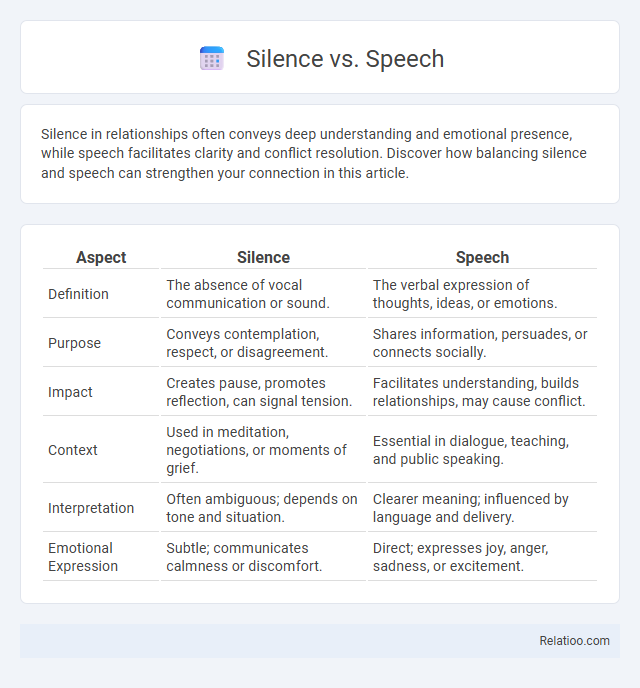Silence in relationships often conveys deep understanding and emotional presence, while speech facilitates clarity and conflict resolution. Discover how balancing silence and speech can strengthen your connection in this article.
Table of Comparison
| Aspect | Silence | Speech |
|---|---|---|
| Definition | The absence of vocal communication or sound. | The verbal expression of thoughts, ideas, or emotions. |
| Purpose | Conveys contemplation, respect, or disagreement. | Shares information, persuades, or connects socially. |
| Impact | Creates pause, promotes reflection, can signal tension. | Facilitates understanding, builds relationships, may cause conflict. |
| Context | Used in meditation, negotiations, or moments of grief. | Essential in dialogue, teaching, and public speaking. |
| Interpretation | Often ambiguous; depends on tone and situation. | Clearer meaning; influenced by language and delivery. |
| Emotional Expression | Subtle; communicates calmness or discomfort. | Direct; expresses joy, anger, sadness, or excitement. |
Introduction: The Power of Silence and Speech
Silence holds profound power in communication, offering moments for reflection and emotional clarity that speech alone cannot achieve. Your ability to balance silence with spoken words enhances understanding and creates meaningful connections. Mastering when to speak and when to remain silent is essential for effective dialogue and emotional intelligence.
Historical Perspectives on Silence and Speech
Historical perspectives on silence and speech reveal diverse cultural interpretations, where silence often symbolized respect, contemplation, or social control, contrasting with speech as a means of power, expression, and resistance. In ancient Greece, silence was valued in philosophical traditions for promoting wisdom, while oratory skills signified civic engagement. Throughout history, marginalized groups used silence strategically to preserve identity or avoid oppression, highlighting its complex role alongside speech in shaping societal dynamics.
The Psychology Behind Remaining Silent
Remaining silent in social interactions often reflects complex psychological processes such as self-regulation, introspection, and conflict avoidance. Silence allows individuals to process emotions and thoughts internally, promoting emotional resilience and reducing impulsive reactions. Neuroscientific studies reveal that controlled silence activates brain regions linked to executive function and emotional regulation, highlighting its role in mindful communication and psychological well-being.
The Benefits of Speaking Out
Speaking out fosters mental clarity by transforming internal thoughts into coherent expressions, which enhances emotional well-being and reduces stress. Vocalizing concerns can build stronger social connections, promoting empathy and support within communities. Active communication encourages problem-solving and personal growth, empowering individuals to advocate for themselves and others effectively.
Cultural Interpretations of Silence vs Speech
Cultural interpretations of silence versus speech vary significantly across societies, where silence can symbolize respect, contemplation, or dissent, while speech may demonstrate authority, connection, or disruption. In many East Asian cultures, silence is valued for maintaining harmony and showing politeness, contrasting with Western cultures that often prioritize verbal expression as a sign of engagement and openness. Understanding these cultural nuances helps you navigate communication effectively in diverse social contexts, avoiding misunderstandings and fostering deeper connections.
Silence in Conflict Resolution
Silence in conflict resolution serves as a powerful tool that allows emotions to settle and encourages reflective thinking. By embracing silence, Your ability to listen actively improves, creating space for understanding and reducing escalation. Strategic pauses often facilitate empathy and clarity, making silence a crucial element in resolving disputes effectively.
When Speech Drives Change
Speech drives change by transforming silence into action through powerful communication and the expression of ideas. Your voice can break barriers, inspire movements, and challenge the status quo, making silence a catalyst rather than a void. Strategic speech mobilizes communities, shifting perceptions and sparking social, political, or personal transformation.
The Risks of Staying Silent
Silence in critical situations often leads to unaddressed misunderstandings, perpetuating conflicts and emotional distress. Suppressing speech increases the risk of mental health issues, such as anxiety and depression, due to unresolved feelings and thoughts. Speaking out promotes clarity and resolution, whereas staying silent may hinder personal growth and damage relationships over time.
Balancing Silence and Speech in Relationships
Balancing silence and speech in relationships fosters deeper understanding and emotional connection by allowing partners space for reflection while promoting open communication. Strategic silence can convey empathy and respect, creating moments for listening and validating feelings without interrupting the flow of dialogue. Maintaining this equilibrium helps prevent misunderstandings and supports healthy conflict resolution, enhancing overall relational harmony.
Choosing Silence or Speech: Key Factors and Considerations
Choosing between silence and speech depends on context, emotional intelligence, and desired outcomes. Silence can convey respect, allow reflection, or de-escalate tension, while speech facilitates clarity, connection, and problem-solving. Understanding Your audience, purpose, and timing ensures effective communication and meaningful interactions.

Infographic: Silence vs Speech
 relatioo.com
relatioo.com